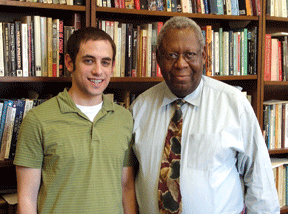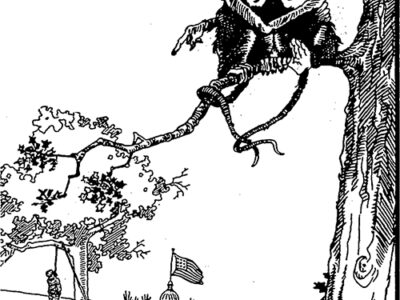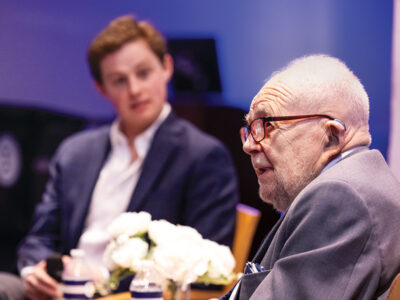
When Corey Brooks C’03 took a $10-an-hour gig as a research assistant the summer after his sophomore year, the history major hardly knew what he was getting himself into. For one thing, lunch breaks would often take place in his boss’s West Philadelphia kitchen. For another, his original six-week commitment would end up stretching to seven years. But the end result was even more unusual, for an undergraduate in the humanities. When the project finally reached its culmination—between the canvas covers of a scholarly book—Brooks’ name was on the title plate right next to that of his erstwhile professor, historian Robert Engs.
Their Patriotic Duty: The Civil War Letters of the Evans Family of Brown County, Ohio, published in November by Fordham University Press, is a remarkable volume quite apart from the uncommon student-teacher collaboration that produced it. It presents an extraordinary collection of family correspondence spanning the Civil War, including letters sent from the Battle of Shiloh and other areas of conflict, as well as missives penned by the men and women at home. The result is an exceptionally detailed portrait of a Northern farm family whose lives and attitudes were upended by a war that touched youthful sisters and elderly parents no less than the soldiers who actually fought.
It has been a project long in the making—and one that only came about thanks to a West Philadelphia resident whose daughter would go on to attend Wharton.
The Evans correspondence landed in Engs’ lap by way of a neighbor in his babysitting co-op. Ann Evans Guise remembers first laying eyes on the letters during a 1973 visit to her aunt’s Ohio home, which still lacked electricity and running water at the time. Told that a cache of yellowing, pencil-scratched stationery had been tucked away in an old mill on the property, Guise went off to search for it. “We walked through grass about this high,” she recently recalled, holding her palm just below her waist. “I was scared to death of snakes. And we went up to the second floor of this mill—I had visions of us crashing through. And then we found this shoebox—or several shoeboxes, because there were so many letters.”
When she handed them to Engs some years later, she says, “he was just placating me to take a look at them.” But the way she remembers it, her imposition turned into a scholarly windfall in short order. “I left his house on 46th Street and walked back to my house on 47th Street, and by the time I got home, the phone was ringing: ‘Ann, this is Bob. This is a treasure. We’ve got to talk.’”
After the first flush of excitement, years passed. By the time Brooks signed on to help, Engs had enlisted more than a dozen previous research assistants to help with transcription and analysis. “But Corey’s not like any research assistant I’ve ever had,” he says.

“For that first summer, because the history department was being evicted from its quarters in College Hall, I didn’t actually have an office with air conditioning. So we sat at my dining room table with the letters and transcripts and the computer,” Engs explains. “Corey was doing the annotation, so when we’d find something we felt needed to be explained, he would go do the research to explain a particular term that was used or event that was described, and so on. And it became a real contest, because he was so thorough that I would say, ‘Listen, there’s not going to be any room for the letters with all the footnotes—and the length of the footnotes—you’re doing!’”
For Brooks, the footnote work was like a master class in becoming a professional historian. “Each one was almost an individual research project in itself,” he says. Delving so deeply into the family’s letters gave the undergraduate a taste for 19th-century private correspondence that proved addictive. When it came time to write a senior thesis—and later as a graduate student in history at UC-Berkeley, where he is currently pursuing a PhD—Brooks found himself gravitating toward old letters.
“Working with these letters absolutely gave me a comfort level with using correspondence to try to get insight into people’s social thinking and political thinking,” he says. By the time he’d graduated and Engs asked him to come on as a co-editor of the book, Brooks felt like he partly owned the project already.
The striking thing about the Evans correspondence is the way it shows various family members stumbling almost blindly toward a fundamentally different set of social and political beliefs as the war drags on. Despite their alignment with the Union and Lincoln’s Republican party, for instance, many of the Evans clan viewed the prospect of black freedom and enfranchisement with considerable trepidation throughout the conflict.
“We tend to distort history when we study it, because we already know what the outcome was,” Engs observes. “Reading these letters, you can get a real sense of people in the process of watching things happen to them, as opposed to knowing how it was all going to come out.”
One of the most fascinating exchanges in the collection comes when Andrew Evans, the family patriarch, discovers that his son Samuel has volunteered to serve as an officer in the United States Colored Troops division. In letters to Samuel in May 1863, he fumes that “I would rather clean out S–t houses at ten cents pr day” than take such a “degraded position” in “the Nigger service.”
Samuel defends his decision in decidedly non-idealistic terms. He points out that his promotion to officer will earn him a horse, saving him from “a heavy load and Sore feet,” and that black soldiers “will do as well to receive Rebel bullets and would be likely to save the life of some white men.”
Yet a mere two years later, both men had altered their attitudes almost completely. “At the end, Samuel seems to be genuinely committed to the cause of black freedom,” Engs says. “And Andrew seems to be even more radical than Sam—because he says, ‘I’d rather vote with a patriotic black man who helped save the country than a white traitor’ … At the end he writes to Sam and says, ‘I’m proud to tell you that I voted with the Ohio state legislature to end slavery.’”
Samuel’s personal and political transformation was particularly resonant for Brooks, who hopes to become a history professor. “He’s very much coming of age during the course of the war, and he’s really becoming an adult. It’s ironic, because he’s actually 29 or 30 when he goes off to war, but he sort of develops over the course of the war a relationship with his father as an equal, and develops an added confidence in himself.”
For Ann Guise, Samuel’s great-granddaughter, that historical record has a distinctly personal edge. The venom her forebears voiced about the black Americans they were nominally fighting to liberate “horrified” her, she says. “But then, see, I grew up with my mother’s family, who shared some of those sentiments a century on. The fact that Sam took up the courage to fight for justice is encouraging.”
Samuel Evans’ metamorphosis suggests another parallel with Guise’s life—one documented in the autobiography of the late Stokely Carmichael, an activist and Black Panther leader whom Guise came to consider a “very, very close friend.” In the book Guise is portrayed as a naive Southern belle who appears one day at the Washington headquarters of the Student Nonviolent Coordinating Committee, hoping to help. Unable to pronounce the preferred term Negro to the liking of any of the men and women there, she is instructed by Carmichael to remove it from her vocabulary. Yet several decades after that early encounter, when the pair reconnects during one of the activist’s visits to the United States from his self-imposed exile in Africa, he describes her with great warmth as “the blackest white woman I know.”
As a specialist in Civil War history and the postbellum South, Engs points out that when historians turn to issues of race during the conflict, especially with regard to black troops, the readiest sources tend to be memoirs written by idealistic white officers. “When you read people like Sam, you get a much better sense that the North was very ambivalent about this whole emancipation business—so that you could have divisions within families, as we have between Andrew and Sam,” he says. “A family like the Evans, I think, were much more typical of how Northerners felt about race.”
—T.P.




